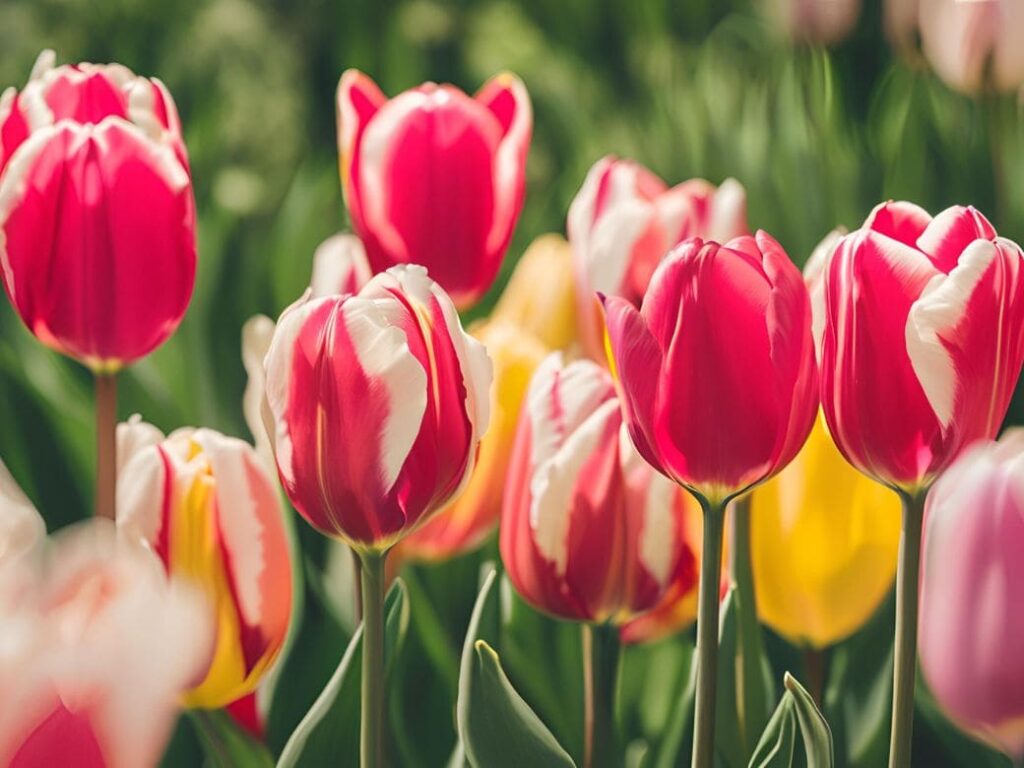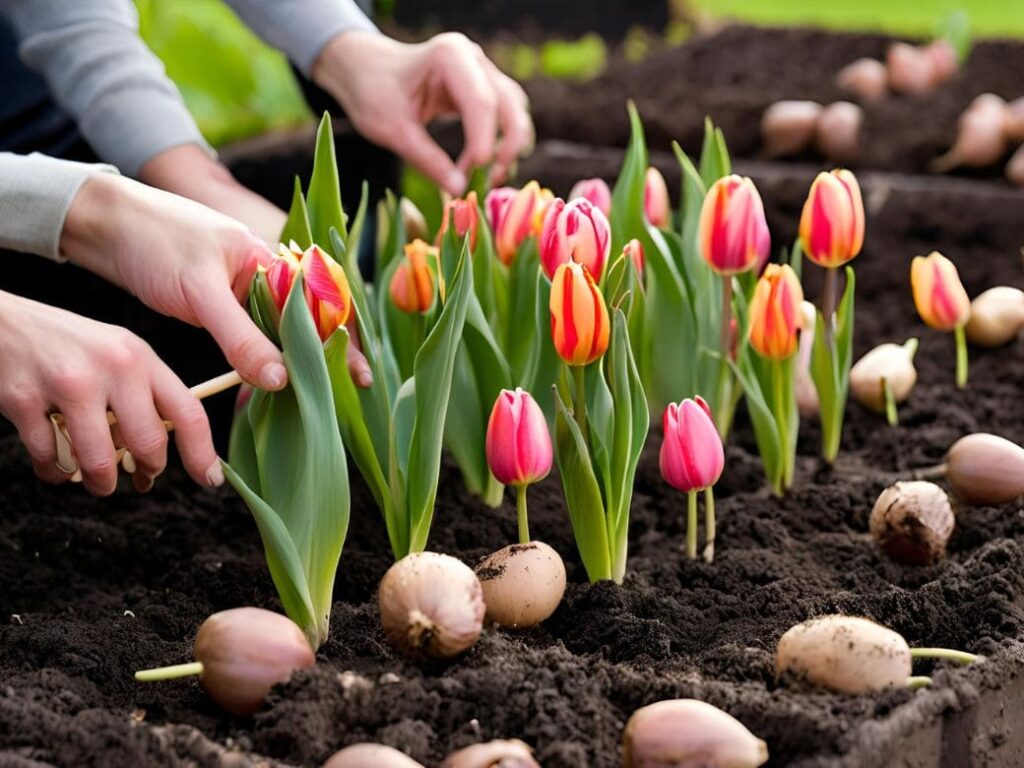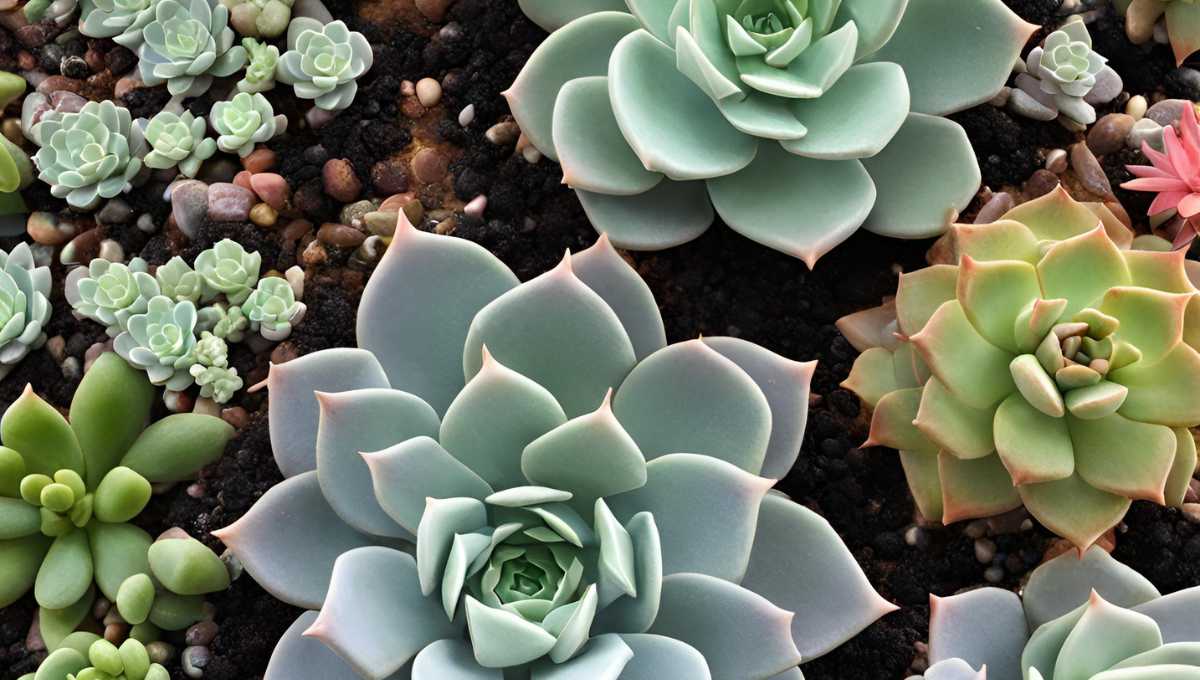
Learn essential tips for planting tulips, from choosing the right bulbs to caring for them and when to plant tulips for a vibrant spring garden.
Long live the tulip! These lovely flowers make our spring days brighter. We eagerly wait for their blue-green leaves to appear as winter ends. Here are some tips on how to grow and care for tulips in your garden.
About Tulips
Tulips usually start emerging from the ground in late winter or early spring. If warm weather causes early growth in the winter, don’t worry too much. Tulips (and daffodils) are quite cold-tolerant. If freezing temperatures return, it may delay their growth. Snow can actually help by insulating the foliage from extreme cold.
In This Post
ToggleWhen to plant tulips:Plant tulips in the fall to get flowers in the spring!
Tulip bulbs are planted in the fall, 6 to 8 weeks before the ground freezes. By choosing varieties with different bloom times, you can have tulips blooming from early to late spring. Some types can be forced to bloom indoors, and most are great as cut flowers.
Tulip flowers usually have a cup shape with three petals and three sepals. They come in various sizes and shapes, from small “species” tulips for woodland areas to larger ones for formal garden beds and borders. The flowers can be single or double and range from simple cups to more complex forms. They grow from 6 inches to 2 feet tall, with one flower per stem and two to six broad leaves per plant.
Are tulips annual or perennial plants?
Tulips are technically perennial plants, but years of hybrid breeding have weakened their ability to return each year. As a result, many gardeners treat them as annuals and plant new bulbs every autumn. The climate and soil in North America are different from the conditions where tulips originally grew in Anatolia and southern Russia.

How to Choose Tulips
Most tulips you see in gardens and stores are hybrid tulips. Hybrid tulips usually need to be replaced each year for the best display. (You can try to get them to come back, but more on that below.) Species tulips are perennial in zones 4 to 7 and will return every year if grown in the right conditions. These tulips are shorter than hybrids, with smaller flowers and pointier petals.
Individual tulips, especially hybrids, do not bloom for long. However, there are early-, mid-, and late-season varieties that bloom at different times. To have flowers all season, choose a few varieties from each bloom time category when buying.
Where to Plant Tulips
Tulips need full sun for the best display, meaning at least 6 hours of bright, direct sunlight each day. They also prefer fast-draining soil, which makes them great for rock gardens.
When to plant tulips
Plant tulip bulbs in the fall, about 6 to 8 weeks before a hard frost. This gives the bulbs time to grow roots. Planting too early can cause disease issues, so check local frost dates. A good rule is to plant when nighttime temperatures are in the 40s. In colder northern areas, plant in September or October, while in warmer areas, you can plant in December or later. For the best planting dates, refer to a fall bulb planting chart.
Bulbs should not stay above ground for long, so don’t delay planting after you buy them. In southern areas with mild winters, plant bulbs in late November or December, but make sure to chill them in the refrigerator for about 12 weeks beforehand. If you miss the ideal planting time, don’t wait for spring or next fall. Even if you find unplanted bulbs in January or February, go ahead and plant them.

How to Plant Tulips
- Plant bulbs about 8 inches deep, or three times their height. Make the hole deeper to loosen the soil and help with drainage. In clay soil, plant them 3 to 6 inches deep instead.
- Space the tulip bulbs 4 to 6 inches apart. Place the bulb in the hole with the pointy side up, cover it with soil, and press it down firmly. Water the bulbs right after planting. They need water to grow, but they don’t like to stay wet.
- If you’re growing perennial tulips, use balanced fertilizer when you plant them in the fall. Bulbs have all the nutrients they need for one year. You can add organic material, compost, or a time-release bulb food.
- To keep mice and moles away, place holly or other thorny leaves in the holes. Some gardeners use cat litter or gravel. If voles and rodents are a big issue, consider planting the bulbs in wire cages.
- Don’t worry if you plant your tulips later in the season; just follow these tips.
How to Water Tulips
Water the tulips when you plant them, soaking each area well. For the first month, water them once a week, then stop until spring. In the spring, start watering again when the leaves begin to grow.
How to Feed Tulips
After the flowers fade, apply Miracle-Gro® Shake ‘n Feed Rose & Bloom Plant Food according to the package instructions. This will encourage leaf growth, helping the bulb store nutrients for the next season. Feed your tulips for the last time in late fall, around the time you would plant new bulbs.

How to Cut Tulips for Indoor Enjoyment(when to plant tulips)
Cut tulips when the buds are still tight. The petals might look a bit green, but you should see the flower color. Put them in a clean vase with room-temperature water. Tulips will keep growing (the stems will get longer) after you cut them. If they get too long, trim a few inches off the bottom of the stems every couple of days. To make cut tulips last longer, add Miracle-Gro® for Fresh Cut Flowers to the water and change the water every few days.
When to plant tulips and What to Do After Tulips Bloom
In most gardens, the best tulip display happens in the spring after planting the bulbs in the fall. To help species of tulips return each year, cut the flower stalk down to the base once the flowers fade. Feed the bulbs as needed, stop watering when the bulbs go dormant, and cut back the leaves once they are completely brown. For hybrid tulips (which don’t come back), just remove the bulbs and compost them.

How to Protect Tulips from Deer and Other Insects
The biggest challenge in growing tulips is keeping deer from eating the flowers, followed by preventing chipmunks and squirrels from digging up the bulbs. To stop pests from disturbing the bulbs, line the planting holes or trenches with chicken wire, which works well if you’re planting a large number of bulbs.
To keep deer away, the most effective method is to install a tall fence (8 feet or more), but that may not be practical for everyone. Since deer avoid daffodils and Crown Imperial bulbs, planting tulips alongside these can help deter them. You can also spray the bulb foliage with a deer repellent. If deer are a significant issue in your area, consider growing tulips in pots on a screened-in porch where they can’t reach them.
Do Tulips Come Back Each Year?
Unlike some spring-flowering bulbs like daffodils, tulips are generally not considered perennials, meaning you may not know until the following spring if they will bloom again. In certain areas, some types of tulips can be perennial, but in many places, they don’t rebloom, so it’s common to treat them as annuals and plant new bulbs each fall. If you want tulips that might come back, consider two-toned varieties like Lilac Wonder or Lady Jane.
To help your tulips return, plant them alongside other perennials and annuals to keep them from getting too wet, as tulips prefer a dry bed during their summer dormancy. Deadheading, or cutting off the seedpod after the petals fall, can also help because it prevents the plant from wasting energy on making seeds instead of next year’s flowers. It’s best to remove the foliage about eight weeks after the tulips bloom or when it turns yellow and can be pulled away easily. Don’t do this too early, as the leaves need time to photosynthesize and provide food for the next year’s blooms.
If you need to move your tulips to a different location, wait until the foliage has died back to allow the tulips to complete their growing cycle. Dig up the bulbs, brush off the soil, and let them dry. Store them in dry peat moss or wood shavings in a cool, dark place. Replant them in the fall.





